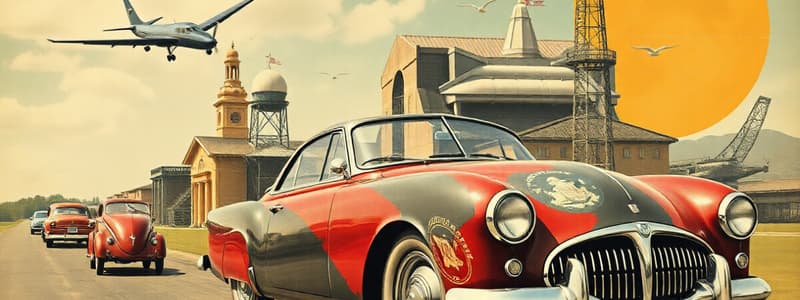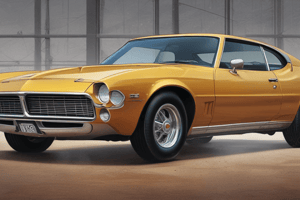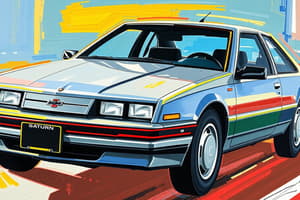Podcast
Questions and Answers
Explain how the bicycle industry indirectly contributed to the development of automobiles.
Explain how the bicycle industry indirectly contributed to the development of automobiles.
The bicycle industry served as a training ground and source of expertise for many early automobile manufacturers. They gained experience in manufacturing, design, and marketing, which they then applied to the emerging automobile industry.
What was the significance of the 'Stockton and Darlington Line' in the history of transportation?
What was the significance of the 'Stockton and Darlington Line' in the history of transportation?
The Stockton and Darlington Line holds significance as the first railroad. This marked a crucial advancement in transportation technology paving the way for future railway systems.
Describe the key innovation that John Boyd Dunlop introduced, and explain its impact on transportation.
Describe the key innovation that John Boyd Dunlop introduced, and explain its impact on transportation.
John Boyd Dunlop invented the 'pneumatic bicycle tire.' This invention significantly improved the comfort and efficiency of bicycles, leading to greater adoption and further development of the bicycle. Dunlop's pneumatic tire technology was later adapted for use in automobiles.
How did the development of the internal combustion engine revolutionize both land and air transportation?
How did the development of the internal combustion engine revolutionize both land and air transportation?
In what ways did the World Wars accelerate advancements in air transportation?
In what ways did the World Wars accelerate advancements in air transportation?
Explain how Mc Adam's road design differed from Roman road construction techniques and why this was significant for road building?
Explain how Mc Adam's road design differed from Roman road construction techniques and why this was significant for road building?
Describe how the invention of the wheel influenced early methods of transportation, prior to 3000 BC.
Describe how the invention of the wheel influenced early methods of transportation, prior to 3000 BC.
Compare the primary advantage of water transportation to road transportation before the advent of railways.
Compare the primary advantage of water transportation to road transportation before the advent of railways.
Identify what natural forces, other than animal or human muscle, were used to power transportation in ancient times. Give an example.
Identify what natural forces, other than animal or human muscle, were used to power transportation in ancient times. Give an example.
Explain the relationship between technological advancements in transportation and societal development, using roads as an example.
Explain the relationship between technological advancements in transportation and societal development, using roads as an example.
How did the use of animal power for transportation vary geographically in ancient times? Provide two specific examples from different regions.
How did the use of animal power for transportation vary geographically in ancient times? Provide two specific examples from different regions.
What impact did the limitations of pre-railway road transportation have on the types of goods that could be transported efficiently?
What impact did the limitations of pre-railway road transportation have on the types of goods that could be transported efficiently?
What does the word 'transportation' mean, and what are the Latin roots of the word?
What does the word 'transportation' mean, and what are the Latin roots of the word?
Flashcards
Railway locomotive
Railway locomotive
Developed in 1814, used for hauling coal.
Stockton and Darlington Line
Stockton and Darlington Line
The first official railway line.
Bicycle Industry's Role
Bicycle Industry's Role
Industry that acted as a foundation for automobile manufacturing.
Etienne Lenoir's Invention
Etienne Lenoir's Invention
Signup and view all the flashcards
Wright Brothers' First Flight
Wright Brothers' First Flight
Signup and view all the flashcards
Transportation
Transportation
Signup and view all the flashcards
Sled
Sled
Signup and view all the flashcards
Ancient Cart
Ancient Cart
Signup and view all the flashcards
Wheel
Wheel
Signup and view all the flashcards
Animal Power
Animal Power
Signup and view all the flashcards
Wind Power
Wind Power
Signup and view all the flashcards
Water Transportation
Water Transportation
Signup and view all the flashcards
Roman Roads
Roman Roads
Signup and view all the flashcards
Study Notes
- Transportation's history is divided into periods based on the primary source of motive power. These include human/animal muscle, natural forces like wind and gravity, and fuel-operated machines.
- "Transportation" is derived from Latin words "Terans" and "Portare," which mean "across and move" and "to carry" respectively.
Manpower
- Sleds were used in the Stone Age for transporting firewood and hunted animals.
- Ancient carts were sleds mounted on wheels.
- The wheel was invented in 3500 BC in Mesopotamia in the Tigris-Euphrates valleys.
Animal Power
- Animal muscle power was widely used for transport in Ancient Egypt and other river valley civilizations.
- Ox, ass, and camel were tamed in the Middle East around 3000 BC.
- Reindeer were used in Arctic Snow areas
- Elephants were used in India.
- Llamas were used in Peru.
Wind Power
- Primitive people migrated over the oceans long before 3000 BC, using crude skin sails on rafts or canoes.
- Three-mast ships were developed in 1450 AD.
Water Transportation
- Boats have been a means of transportation for humans since prehistoric times.
- Early boats were floating logs or driftwood used like canoes.
- The steamboat was invented in 1783 by Marquis de Jouffroy de Abbans.
- Ships and submarines came later.
Roads and Vehicles
- Romans brought road building to its peak in ancient times having a total of 50,000 miles (80,000 km) in its road network.
- Roman roads were costly due to deep foundations of layered heavy stones suitable for heavy traffic.
- In 1815, John Mc Adam improved road construction in England with macadamized roads
- Mc Adam ensured roads were watertight and curved so water would run off.
- Coaches averaged about 4 mph (6.4 kph).
Canals and Railways
- Canals and railroads developed from the need to improving heavy freight transportation
- In 1814, the railway locomotive for hauling coal was fully developed
- The first railroad was the "Stockton and Darlington Line."
Bicycles
- Bicycles are important because the bicycle industry acted like a "nursery" for automobile builders.
- In 1818, bicycles had wooden wheels and were pushed by feet.
- In 1865 a bicycle with pedals was developed.
Automobiles
- Early automobiles ran on four bicycle wheels referred to as "Steam Traction Engines" at the end of the 19th century.
- Etienne Lenoir invented a vehicle driven by an internal combustion engine
- By 1865, 400 Lenoir Gas engines existed in France.
- Nicolaus Otto and Gottlieb Daimler pioneered gas engine manufacturing, and Daimler became a successful automobile manufacturer.
- John Boyd Dunlop invented the pneumatic bicycle tire in 1888.
Air Transport
- Air transportation began with the combustion engine.
- The Wright brothers made their first flight in Kitty Hawk, North Carolina, in 1903.
- Orville Wright flew a gasoline-powered biplane for 12 seconds.
- Air transport progressed rapidly in WW1 and WW2.
- Later the jet engine and rocket development opened up the era of space exploration.
Studying That Suits You
Use AI to generate personalized quizzes and flashcards to suit your learning preferences.
Related Documents
Description
Explore key milestones in transportation history, from the bicycle industry's influence on automobiles to the impact of the internal combustion engine on land and air travel. Examine innovations like Dunlop's tires and Mc Adam's road design, and understand how the World Wars accelerated advancements in air transport.



